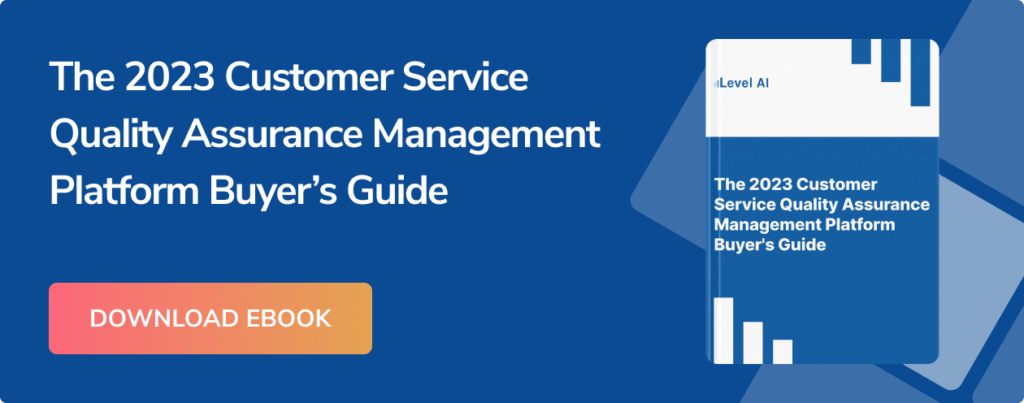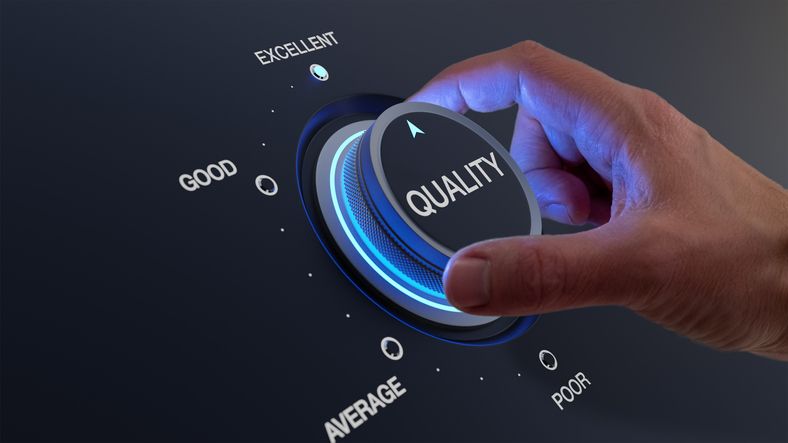Complete Guide: What Is Contact Center Quality Management and How to Add AI


Contact centers are an essential element of customer support for companies of all kinds. However, the modern customer and their needs are constantly evolving, and it’s essential that businesses are frequently evaluating and improving their contact centers to keep up.
In order to analyze and optimize your contact center, you need data to understand its performance, and to get that crucial data, you need a system in place to collect and check it. Enter: contact center quality management. In this blog, we’ll define what contact center quality management entails, explore its benefits and importance for businesses of all kinds, and determine how to create a Q/A framework that works for your call center.
What Is Contact Center Quality Management?
Contact center quality management (QM) is a solution that gives you the tools to continuously measure and monitor agent performance, assess the quality and depth of your customer interactions, and drive constant improvement. Contact center quality management is a means of measuring Quality Assurance (QA), which ensures your product or service is performing according to company and consumer standards.
Every agent is different, and therefore, every agent excels in different customer interactions and different learning environments. Contact center quality management empowers businesses to better understand how different agents perform and make important adjustments to create the most positive customer interactions. Making business decisions comes down to having the data to inform and direct them, and QM collects and helps to analyze the data for the optimization of everything about your contact center.
Why Is Contact Center Quality Management Important?
If we’re asking the question, “Why is contact center quality management important?” the question really becomes, “Why is data about my contact center important?” This question is the heart of what makes contact centers successful, and there are number of different answers:
- Agent data allows businesses to optimize agent performance for better customer interactions
- It helps companies create the most optimal environment to reduce agent churn and help agents feel confident about their various skills
- Customer interaction data helps businesses better understand their customer base and improve the methods and styles with which they communicate with customers
- All of this data informs decisions that can improve customer interactions, make the larger customer base more satisfied earlier on, enhance agent service techniques, and decrease agent turnover
What Are the Benefits of Contact Center Quality Management?
There is an incredibly wide range of benefits as a result of integrating contact center quality management into your call center operations, from keeping your agents happy to keeping your customers coming back.
Reduce agent churn
Agent churn is one of the biggest problems facing contact center leaders. Amid the Great Resignation and a booming job market, it is getting increasingly challenging to hire and retain call center agents. Collected and analyzed data about contact center agents helps call center managers better understand their agents’ needs, provides agents with timely feedback, improves agent learning opportunities, and increases their engagement with the company, reducing agent churn overall.

Receive automated insights
Many contact center softwares have the ability to capture and catalog some customer interaction data but are not stored in an efficient or accessible way. The right QM provides essential accessibility and automation of customer interaction data. By automating the storing, tagging, searching, and selecting of interaction data, agents are freed up from the tedium of these manual tasks and given more time and energy to spend in meaningful support conversations with customers.
Increase CLTV
CLTV, or customer lifetime value, is the total worth to a business of a customer over the whole period of their relationship. It’s an important metric, as it costs less to keep existing customers than it does to acquire new ones, so increasing the value of your existing customers is a great way to drive growth. Contact center quality management data helps businesses to optimize customer interaction performance, making it easier to nurture and maintain relationships with existing customers — turning one-time purchasers into lifelong advocates.

Establishing a Contact Center Quality Assurance Framework
What is a Q/A framework?
A call center quality assurance, or Q/A, framework includes metrics and a set of criteria for success that you use to manage and measure your service quality. The framework guides your quality monitoring for your call center, helps clearly define key performance indicators (KPIs), and how you analyze the results.
What are the 3 types of Q/A frameworks?
There are three primary types of Q/A frameworks, and each is beneficial to contact center quality management in different ways, depending on the size and complexity of the call center and the organization.
1. Operational call center quality assurance framework
The operational call center Q/A framework acts as the starting point for virtually all call centers. This framework is designed to support the core processes at the heart of the call center. The operational framework generally includes:
- Measuring QA daily
- Identifying poor performers using QA data
- Setting monthly score quotas for call center agents
- Conducting monthly evaluations
There are a few challenges to this Q/A framework. It can be difficult to turn metrics from the data you’re collecting into actionable insights, as the focus of this framework is primarily data collection rather than analysis. With this in mind, limited resources for collecting and analyzing data may mean less meaningful quality assurance.
2. Tactical call center quality assurance framework
The tactical call center Q/A framework goes beyond daily customer service goals and sets tailored, medium-term goals. This framework is more flexible and allows call center leaders to modify their Q/A processes based on the collected data. The tactical call center framework generally includes:
- Identifying the cause of low KPIs
- Figuring out which processes and workflows need adjustment
- Improving customer retention
- Reducing agent turnover by investing both money and time in training
- Deducing performance trends from data over time
This framework, while more adaptable than the operational framework, has its own challenges, as well. For example, it doesn’t take into consideration external factors that can allow contact center leaders to be even more strategic about their quality assurance data and how it is analyzed.
3. Strategic call center quality assurance framework
The strategic call center Q/A framework structures your call center in a way that allows you to analyze, interpret, and share data about your business’s strategic goals and objectives. This framework generally includes:
- Increasing customer loyalty long-term
- Examining the impact of customer service on sales to increase revenue
- Boosting your net promoter score (NPS) by understanding how customer sentiment, customer service, and Q/A intersect
While the strategic call center Q/A framework is arguably the most advanced of the three, it takes time and resources of improvement within the first two frameworks before having the process and strategy in place to properly utilize this framework.
How To Set Up a Contact Center Q/A Framework

Know your priorities
In order to begin establishing a contact center quality assurance framework, call center leaders and their organizations need to know what standards and ideas they want to uphold with their contact center. These will evolve as the business and the customer evolves, but it provides an essential baseline to propel the team forward.
Establish dissatisfied customer policies
It is crucial for contact center leaders and their companies to agree on thorough policies for how to handle dissatisfied customers. The policies can include offering refunds and replacements or filing official complaints — they can even include something very specific to your business that you can work to become known for.
Once finalized, ensure this policy is officially disseminated and every agent is trained on these specific methods. KPIs, policies, protocols — none of these means anything unless every agent is thoroughly trained on how to handle dissatisfied customer interactions in a way that is representative of your brand.
Determine metrics and KPIs
Before collecting agent and contact center data, it’s important to decide in advance which metrics and KPIs to measure against based on company priorities. This helps call centers avoid collecting irrelevant data that only bogs down the process. Then, create agent performance cards around these and other metrics that evaluate overall agent performance. Some important metrics to consider include:
- Customer Satisfaction Score (CSAT): While customer satisfaction as an idea is a general one, CSAT is a more defined metric that’s expressed as a percentage
- Repeat Customer Rate (RCR): Proportion of your customers who have made at least two purchases during a certain time period.
- Negative Response Rate (NRR): Shows how many negative customer responses an agent receives vs positive responses as a percentage
- First Contact Resolution (FCR): Measures the number of customer contacts that are resolved on the first interaction with the customer
Keep rubrics simple and objective
Subjectivity in your data collecting often results in inconsistent and unfair grades, and thus creating unclear feedback. This can lead to agent disappointment despite best efforts to improve, the feeling of being unfairly graded, and finally, agent churn.
Similarly, complex rubrics are too difficult to follow and unlikely to impact behavior in a meaningful way. Remember, agents already have thousands of pieces of information to keep in mind, all while researching and trying to maintain a positive rapport with the customer. Cognitively overloading them with a complicated rubric will often result in them simply ignoring it in order to stay on top of the rest of their duties.
“The biggest investment you can make in your training is not a tool or a system; it’s the time of your trainers and your content writers to continually review your content and ensure it’s delivering what your team needs today.”nnMatthew Caron – Head of Customer Support, OpenTable
The Benefits of AI in Contact Center Quality Management
While there are certain elements of the contact center customer experience that only the human touch can do effectively, blending intelligent AI with human compassion can create the ultimate customer support experience. Level AI’s contact center quality management solution offers a number of features that optimize the quality management process with AI, including:
- Natural language understanding (NLU) of customer intent with 2X the accuracy and minimal maintenance
- Semantic intelligence analyzes, scores, and tags key moments in every agent conversation
- VoC (Voice of Customer) can automatically deliver custom reports to contact center leaders, as well as other business teams, such as product and compliance
- API allows you to seamlessly push large amounts of data to and from the platform
- Enable autonomous learning for agents by evaluating every interaction across voice calls, email, and chat, including our Agent Screen Recording feature
- Show useful hints to agents throughout a conversation, such as greeting the customer during the beginning of the conversation, confirming their identity, rephrasing their problem before suggesting the solution, and much more
- Models learn and provide better results over time as agents provide feedback and tune preferences to match brand priorities and policies
To learn more about the impacts of AI to improve contact center quality management, request a demo with Level AI today.
Keep reading
View all





